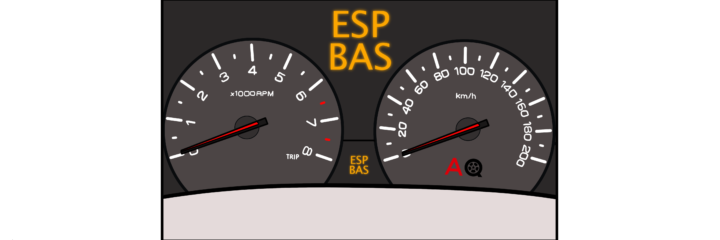No doubt an assortment of indicator lights pops up on the dashboard of your car, and you have no idea what half of them have to do with you. These lights can include the ESP or BAS light. If your vehicle comes with the ESP and BAS systems, then it makes sense that you want to know what they are and, of course, what they have to do with you.
What Is the ESP System?
The Electronic Stability Program (ESP), also called the Electronic Stability Control or Dynamic Stability Control is a car technology designed to improve stability. The system is designed to detect and counteract the loss of grip or balance in a vehicle’s movement by reducing speed. The ESP system is there to assist the driver to regain control of a car experiencing loss of traction in order to prevent potentially dangerous outcomes.
Suppose you are driving in the winter period when the road is covered in snow and ice, and your vehicle struggles to maintain a good grip on the surface, the Electronic Stability Program detects the loss of traction and automatically applies the brakes to help you retain control. The brakes will help minimize oversteering in slippery road conditions, and they can also reduce your engine’s power depending on the kind of vehicle you have.
What Is the BAS System?
The BAS is the acronym for Brake Assist System. It is also commonly known as emergency brake assist. BAS is a smart motoring technology that enhances the pressure of a vehicle’s brakes when the driver is trying to stop in an emergency. For example, when you forcefully hit the brakes in the process of trying to avoid an accident, the BAS detects this urgency, including the speed and force applied on the brake pedal.
BAS is designed to understand and interpret such unique actions and movements as a possible critical situation. As soon as the system fully relays this urgency, it immediately overrides the brakes and increases the pressure on the brakes until the anti-lock brake system disengages the wheels. So, when the ESP or BAS light shows up on your dashboard, know that these systems have been engaged. Note that not all vehicles come with this technology, just some models.
Signs of a Faulty ESP/BAS
ESP light can come on for no justifiable cause. This can be a sign that the module controlling the program is starting to fail. So the light can come on even if you are not having any problem with your traction.
If the ESP or BAS light is on every time, there is a problem that needs to be resolved. It’s probably fine to drive your car with the ESP/BAS light on as long as you contact your nearest automobile mechanic as soon as possible. Below are common signs of a faulty ESP/BAS.
Lights Won’t Turn Off
If the ESP/BAS lights pop up on your dashboard and remain longer than they should, that is a good sign of a bad ESP or BAS. ESP/BAS is a fantastic piece of technology that can save lives as well as enhance the driving experience but random or unreliable timing of the ESP/BAS indicator lights will undermine its efficiency.
Loss of Anti-lock Brakes
Your anti-lock brakes work closely with your ESP and BAS because the same module controls them in your car. If your anti-lock brakes are faulty, the ESP/BAS lights may fail to work properly. Finally, the ESP/BAS systems have been proven to significantly reduce road accidents. So, as a responsible driver, make sure your ESP and BAS lights are working properly.


